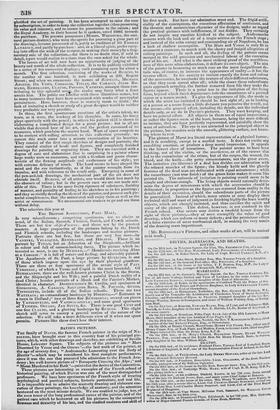DAVID'S PICTURES.
THE family of DAVID, the famous French painter in the reign of NA- PoLtoN, have brought over to this country four of his principal pic- tures, which, with other drawings and sketches, are exhibiting at Saville House, Leicester Square. The subjects of the pictures are " Mars Disarmed by Venus and the Graces "—the last work of the painter, at the age of seventy-five; "Andromache Lamenting over the Body of Hector "—which may be considered his first complete performance, since it was the one that procured Min admission to the French Aca- demy; his well-known picture of" Bonaparte Crossing the Alps ;" and " Mamt Murdered in his Bath "—painted at the desire of the Convention. These pictures are interesting as examples of the French school of historical painting, of which DAVID was one of the most distinguished professors. We have here specimens of the French style of treating mythological and poetical subjects, historic portraiture, and real life. It is impossible not to admire the masterly drawing and elaborate exe- cution of these paintings, the knowledge of anatomy, and the attention bestowed on the most minute details. We are enabled to judge, too, of the even tenor of the long professional career of the painter, and of the patient care which he bestowed on all his pictures, by the unimpaired Srmness and dexterity of his last, and the studied neatness and skill of his first work. But here our admiration must end. The frigid artifi- ciality of the conceptions, the conscious affectation of sentiment, and the theatric and meretricious character of the designs, make us regard the poetical pictures with indifference, if not dislike. They certainly do not inspire any emotion kindred to the subject. Andromache mourns with the look and air of a tragic actress on the French stage; and instead of the calm energy and commanding air of Napoleon, he has a look of shallow assumption. The Mars and Venus is only fit to ornament a staircase, to match with the showy and insipid allegories of ceiling paintings. In each and all, the feeling of the painter seems merged in the cold precision and mechanical labour of the executive part of his art. And what is the most striking proof of the worthless.. tress of this mere ultra-elaboration, it defeats its own object. The aim of the painter in bestowing so much care on the most insignificant de- tails was, of course, to increase the appearance of reality—it has the reverse effect. In his anxiety to imitate exactly the form and colour of the accessories, he overlooks the texture of theirdifferent substances, so that they seem unreal after all; while the closer these subordinate parts approach actuality, the further removed from life they make the figures appear. There is a point too in the imitation of the living form, beyond which finish degenerates into the smoothness of a painted statue or a waxen model. To give the appearance of life, the mode in which the artist has imitated it should be lost sight of; as in looking at a person or a scene from a little distance you perceive the result, not the nicans—the general effect, including the details, not the individual details only, as we do in DAVID'S pictures. They want keeping, and have no general effect. All objects in them are of equal importance; or rather the figures seem of the least, because, being the most difficult to imitate, they are least perfectly represented, and painfully show the want of animation. The eye is not attracted to the principal object in the picture, but wanders over the smooth, glittering surface, not know- ing where to rest. The picture of Marat is a literal representation of a physical horror; and it is revolting, except to a morbid taste. It does not excite any ennobling emotion, or produce a deep moral impression. It appeals to the lowest class of sensations. The painter seems to have been thinking, not of the victim, or the murderess, or of the causes that led to the commission of the crime, but of the corpse, the wound, the blood, and the knife,—the petty circumstances, not the great event. The imitation (to illusion) of a deal box divides our admiration with the relaxed muscles of the figure; the bloody knife and the ghastly features of the dead man are delineated with equal minuteness ; while the smoothness (not true finish) of the green baize makes it seem like painted tin. The rationale of imitation in painting would seem to be simple and obviows enough. The living objects would naturally deter- mine the degree of minuteness with which the accessories should be delineated : in proportion as the figures are removed from reality in the details of their execution, should the subordinate parts of the picture be generalized. Instead of which, many artists at once display their technical skill and want of judgment in finishing highly the least worthy objects, which are cheaply imitated, and thus sacrifice the spirit and unity of the picture. This defect, however, is not confined to the French school. Our artists may derive a twofold lesson from the sight of these pictures,—they at once exemplify the value of good drawing, which can redeem so many defects; and the pernicious effects of a false exercise of mere mechanical skill, in making the very merits of the drawing seem impertinent.
[Mr. RIPPINGILLE'S Pictures, and other works of art, will be noticed next week.]


























 Previous page
Previous page